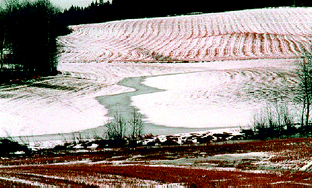Large areas in Europe may experience frozen soils during winter periods which pose special challenges to modelling. Extensive data are collected in small agricultural catchments in Nordic and Baltic countries. An analysis on measurements, carried out in four small agricultural catchments has shown that a considerable amount of the yearly nutrient loss occurs during the freezing period. A freezing period was defined as the time period indicated by the maximum and minimum points on the cumulative degree–day curve. On average 6–32% of the yearly runoff was generated during this period while N-loss varied from 5–35% and P loss varied from 3–33%. The results indicate that infiltration into frozen soils might occur during the freezing period and that the runoff generating processes, at least during a considerable part of the freezing period, are rather similar compared to the processes outside the freezing period. Freeze–thaw cycles affect the infiltration capacity and aggregate stability, thereby the erosion and nutrient losses. The Norwegian catchment had a high P loss during the freezing period compared to the other catchments, most likely caused by catchment characteristics such as slope, soil types, tillage methods and fertiliser application. It is proposed to use data, collected on small agricultural dominated catchments, in the calibration and validation of watershed management models and to take into account runoff and nutrient loss processes which are representative for cold climates, thereby obtaining reliable results.

You have access to this article
 Please wait while we load your content...
Something went wrong. Try again?
Please wait while we load your content...
Something went wrong. Try again?


 Please wait while we load your content...
Please wait while we load your content...